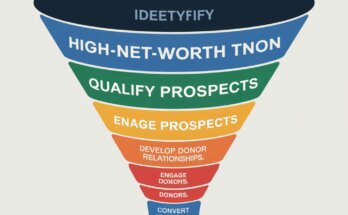Mastering how to attract high-net-worth donors can be one of the most rewarding strategies for any nonprofit organization. These individuals have the financial means to make substantial donations that can significantly boost your nonprofit’s growth and impact.
High-net-worth donors, or major donors, don’t just write large checks—they often bring other benefits like increased visibility, access to influential networks, and a long-term partnership that can lead to sustainable funding for years to come.
But the real challenge is figuring out how to attract and engage them. What makes a high-net-worth donor choose one nonprofit over another? What strategies can you implement to not only get their attention but to inspire them to invest in your cause?
It’s important to remember that high-net-worth donors are typically thoughtful and selective with their philanthropy. They want to be part of a mission that aligns with their values and provides tangible, measurable results.
Understanding this mindset is key to building genuine, lasting relationships.
In this post, we’ll break down actionable steps and strategies that can help your nonprofit successfully connect with and cultivate high-net-worth donors.
The Importance of Targeting High-Net-Worth Donors
High-net-worth donors typically have the financial capacity to make large donations. Establishing long-term relationships with these individuals could lead to consistent, substantial funding.
Think about it this way: instead of trying to secure hundreds of small donations, wouldn’t it be more efficient to build deep relationships with a few major donors who believe in your cause and are willing to make transformational contributions?
Here are the steps you can take to get started.
1. Research Your Donors Thoroughly
The first step in attracting high-net-worth individuals (HNWIs) is understanding who they are. Donor research helps you identify potential donors who are likely to resonate with your cause and have the financial ability to make significant contributions.
Practical Example: Using Wealth Screening Tools
Let’s say you’re running a nonprofit focused on environmental conservation. You could use wealth screening tools to find individuals who have previously donated to similar causes.
Services like WealthEngine or iWave help nonprofits identify high-net-worth individuals by analyzing their philanthropic history, investments, and public financial information.
2. Craft a Compelling Story
High-net-worth donors aren’t just moved by numbers—they’re moved by stories. They want to feel emotionally connected to your cause, and a compelling narrative is your ticket to their hearts.
Tip: Frame your nonprofit’s mission in a way that highlights the problem you’re addressing, the solution you’re providing, and the tangible outcomes. Use storytelling to engage their emotions.
For example, if your nonprofit provides clean water to communities in need, focus on how one family’s life was transformed after they gained access to safe water.
Practical Example: Instead of leading with “We provide clean water to communities,” tell a story about a family that used to walk miles for water, but now, thanks to your nonprofit, the children are healthier, and the parents can work without worrying about their kids’ well-being. This kind of personal story resonates more than statistics.
A Real Story: The Power of a Personal Connection
Let me share with you the story of a nonprofit I once worked with. They were a small organization struggling to gain funding for their education initiatives.
They had a cause that was noble—providing scholarships for underprivileged students—but their approach wasn’t working.
Then they decided to do something different. They told the story of a student named Sarah. Sarah had dreams of becoming a doctor but was held back by financial limitations.
Through a heartfelt video showing Sarah’s determination, struggles, and eventual success (with the help of Hopeful Futures), they connected with a wealthy donor.
That story, filled with authenticity and emotion, resulted in a $250,000 donation from a high-net-worth individual who was touched by Sarah’s journey.
3. Build Personal Relationships
Wealthy donors don’t want to be treated like a transaction. They want to feel valued as partners in your mission. Building personal relationships is key. This means more than just sending a thank-you note after a donation. It’s about cultivating a connection over time.
Strategies for Building Personal Relationships:
- Invite them to exclusive events: Create intimate gatherings where you can discuss your mission and show the impact of their contributions firsthand.
- Regular updates: Provide personalized updates, showing them exactly how their donations are making a difference. For instance, instead of a general newsletter, send a special note highlighting a specific project they’ve helped fund.
- Engage with their interests: Find out what resonates most with your donors—whether it’s education, healthcare, or environmental sustainability—and tailor your communications accordingly.
Practical Example: Let’s say you’re running a nonprofit that supports education in underserved areas. You’ve done your research and know that one of your high-net-worth donors is passionate about STEM (Science, Technology, Engineering, and Math).
In your next update, focus on how their donation has funded STEM programs, showing specific outcomes like the number of students enrolled and the impact it’s having on their education.
4. Leverage Networking and Connections
The wealthy often move in circles where connections matter. Tapping into those networks can be invaluable for your nonprofit. Once you’ve established a relationship with one major donor, don’t hesitate to ask if they can introduce you to others who may be interested in your cause.
Tip: Many high-net-worth individuals are part of clubs, networks, and philanthropic organizations. If you can get a foot in the door by attending events where these donors gather, or if you can get an introduction from someone in your current network, you can expand your reach significantly.
Practical Example: A small arts nonprofit wanted to expand its donor base. After one successful major donation, they asked their donor to host a private dinner with a group of their peers, sharing the mission of the organization. The result? Three new high-net-worth donors were brought on board that night.
5. Offer Exclusive Opportunities
Everyone loves feeling like they’re part of something special, and high-net-worth donors are no different. Offering exclusive experiences or opportunities can set your nonprofit apart from the rest.
What to Offer:
- Exclusive donor tours: Invite high-net-worth donors to visit the communities or projects their donations have helped.
- Behind-the-scenes access: Provide them with a deeper understanding of how your organization operates. Give them the opportunity to meet with your leadership team or frontline workers.
- Exclusive naming rights: For large donations, offer naming rights to certain programs or buildings within your nonprofit. This makes their contribution even more meaningful and personal.
Practical Example: A nonprofit dedicated to wildlife conservation once allowed their major donors to name the newly rescued animals. One donor, deeply passionate about tigers, contributed $500,000 to the cause, knowing that one of the rescued tigers would be named in his honor.
6. Provide Clear ROI (Return on Investment)
High-net-worth donors are often business-minded individuals who want to know exactly what their money is achieving. Make it easy for them to see the return on their investment. This means providing clear, measurable outcomes of how their donation has made an impact.
Examples of ROI for Nonprofits:
- Number of people served.
- Programs launched or expanded.
- Lives impacted (e.g., number of students graduating, patients treated, etc.)
- Long-term change achieved.
Practical Example: If a donor gives $100,000 to fund scholarships, you should provide data on how many students received those scholarships, what fields they’re studying, and the future potential impact of their education. This provides tangible proof that their contribution is making a difference.
7. Create Matching Gift Challenges
Another great strategy to attract high-net-worth donors is by introducing matching gift challenges. These challenges allow donors to maximize the impact of their gift by encouraging others to contribute.
How does it work? A wealthy donor pledges to match donations up to a certain amount within a specific timeframe. This creates urgency and encourages other donors to give, knowing that their donation will have double the impact.
Practical Example: A health nonprofit once partnered with a major donor for a matching gift challenge. The donor pledged to match every donation up to $500,000 within a month. By the end of the campaign, they raised $1 million—double the amount they would have raised without the matching challenge.
8. Recognize and Appreciate Donors Publicly
Public recognition is a powerful tool when done right. High-net-worth donors often appreciate being acknowledged for their contributions—especially when it aligns with their values or personal brand. Recognizing them in front of peers or the public can go a long way in building a lasting relationship.
Ways to Acknowledge Donors:
- Mention them in your annual report or on your website.
- Offer speaking opportunities at your events.
- Create a donor wall in your headquarters.
- Send them personalized gifts or handwritten notes that demonstrate your appreciation.
Practical Example: A youth development nonprofit once created a special “Impact Gala” where high-net-worth donors were invited and recognized for their contributions. Each donor was given the opportunity to speak about why they supported the cause, which not only honored their support but also inspired other potential donors in the room.
9. Focus on Their Legacy
For many high-net-worth individuals, creating a legacy is important. Your nonprofit can position itself as the vehicle through which donors can leave a lasting impact on the world.
How to Create Legacy Opportunities:
- Endowment funds: Allow donors to establish an endowment that supports your organization for years to come.
- Planned giving: Work with donors to incorporate your nonprofit into their estate planning, ensuring that their legacy lives on through your work.
- Naming rights: As mentioned earlier, naming opportunities for programs, scholarships, or even buildings can solidify a donor’s legacy.
Practical Example: A healthcare nonprofit once worked with a high-net-worth donor to create an endowment that would fund free medical care for low-income families. The endowment was named in the donor’s honor, ensuring their legacy would be remembered long after they were gone.
Conclusion: Start Building Meaningful Relationships Today
Attracting high-net-worth donors is about more than just fundraising—it’s about building relationships. These donors want to be a part of something meaningful, and your nonprofit’s mission is the vehicle to fulfill that desire.
Call to Action: Subscribe to Nonprofit Navigators Newsletter!
To learn more expert tips and strategies for growing your nonprofit and attracting major donors, subscribe to the Nonprofit Navigators Newsletter. Each week, you’ll receive valuable insights, fundraising tactics, and practical tools to help your nonprofit thrive. Don’t miss out—join a community of nonprofit leaders and experts today!
Plus, as a bonus, download our free guide “Top 10 Donor Stewardship Strategies for Nonprofits + Free Donor Engagement Checklist” to help you strengthen relationships with your donors and ensure long-term support for your mission.




